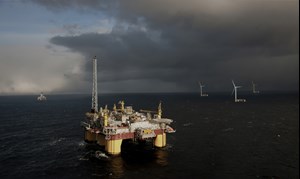DNV completes concept verification review of Odfjell Oceanwind’s WindGrid floating wind power system
OSLO - DNV has completed a concept verification review of Odfjell Oceanwind’s WindGridsystem for Mobile Offshore Wind Units. DNV’s review confirms the technical feasibility of the WindGrid system, and that expected reductions in CO2-emissions for North Sea applications are in the range of 60-70%, compared to generation of electricity from conventional gas turbines.
Odfjell’s WindGrid is a solution for providing an uninterrupted power supply from Mobile Offshore Wind Units (MOUWs) to micro-grids. It combines energy storage, grid converters and floating wind turbines in order to enable gas turbine generators to be shut down during peak wind power production.
“This feasibility verification report marks an important milestone for Odfjell Oceanwind,” said Per Lund, CEO of Odfjell Oceanwind. “It demonstrates that mobile offshore wind units can offer an attractive alternative for the oil and gas industry as it strives to reduce green-house gas emissions. The flexibility of the MOWUs, combined with emission cuts exceeding the industry’s 2030 ambitions, means that the industry can deliver on the green shift faster and more cost effectively than any other alternative that exists today, including power from shore.”
“We were very proud to have been asked to work with Odfjell on this project, continuing to build on our longstanding and productive relationship,” said Erik Henriksen, Director of Business Development - Offshore Classification, DNV Maritime. “Solutions like WindGrid in the new floating wind sector can make a large impact on the speed of the energy transition. This project also demonstrates how our customers can utilize DNV’s deep cross industry expertise, in maritime, wind, and energy, to tap into new markets with confidence.”
DNV’s review, combined technical units from across the entire Group and included a technical assessment of all components, a HAZID to identify hazards that could prevent successful implementation, and a verification of the estimated wind power production with corresponding fuel savings and CO2 emission reductions for the oil and gas installation connected to the integrated MOWU and WindGrid system.



